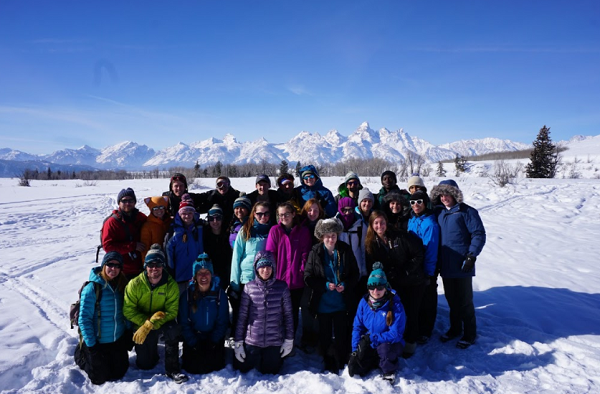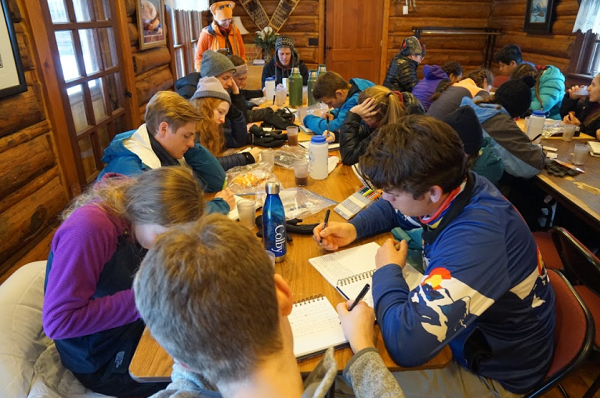Editor’s Note: Today on the blog we’re delighted to feature guest author Lynne Scott of the Principia School. Lynne recently traveled from St. Louis, Missouri to the Tetons, along with 21 Principia students and three other chaperones, for a week at Tetons Science Schools exploring what it means to be a naturalist through science and art. Later in the week, look for excerpts from blogs written by Principia students about their experiences at TSS.

I love what stepping outside can do for us – both literally and metaphorically. In a literal sense, stepping outside in January in the Tetons means both challenge and joy as we navigate the temperatures, skis, and snowshoes. Fresh air all day long, picnics in the snow, pens freezing up as we try to write in the cold, and the ever-changing landscape of the Tetons as clouds roll in and out – these are the norm in outdoor living here. While these literal negotiations and learnings are meaningful, and build character on many levels, it is the metaphorical stepping outside that struck me so much on this particular trip.
On January 22nd, our students stepped outside of their hectic sports and academic schedules for the week. Phones and computers were removed, leaving journals, pens, watercolors, books, hand warmers, and of course anticipation as students stepped into this new place of the Teton Science School in Kelly, Wyoming. Students were told that this experience wasn’t for a grade – it was for the experience, to learn as much as possible. They dove into each activity with authentic interest and appreciation. Students who were often quiet in class or struggled with scientific principles asked solid questions; others rekindled a love of art that they hadn’t explored since they were young kids. Even more students took risks sketching or doing watercolor as naturalists despite identifying themselves as “non-art” people.

What is it that allows for this newfound exploration and expansion? Why is it that we engage differently when we step outside our normal lives? It seems that stepping away from juggling the everyday balls of life (classes, sports, friends, family, social media, etc.) has an impact on our focus and even our willingness to take risks. Is it the change in pace, or perhaps the change in place, that allows for this? Is it the new place – the Tetons – that provides for the space to explore, or can that same space be created in place, here in St. Louis? Is it even possible for this transformation to happen in the places we call home, at the paces our lives take?
As a teacher, I believe that the space to think and explore can be created in any place. It is our job as educators to provide an environment and a curriculum that promote exploration and expansion of thought – that encourage students to take risks and to inquire. We all live in places that are dynamic and deserve to be explored from every angle of the place triangle: ecology, society, and economics. Sure, they don’t all have that gorgeous backdrop of the Tetons, or feature cross-country ski and snowshoe adventures, but diversity has many beautiful faces. Trips like the one we were able to take to the Teton Science School in Wyoming are transformational – and they should be. But this transformation is only as good as the extent to which it is transferred back home and applied in our daily lives.
I am inspired by this trip to help my students re-engage with our own place, to provide opportunities for inquiry, exploration, community building, and self-reflection. I am inspired to engage with a curriculum that provides our students with a way to better understand their place, to have some space to make connections and take risks. Thank you, Tetons Science Schools, for such a rich reminder. I look forward to stepping outside even more with my students.


